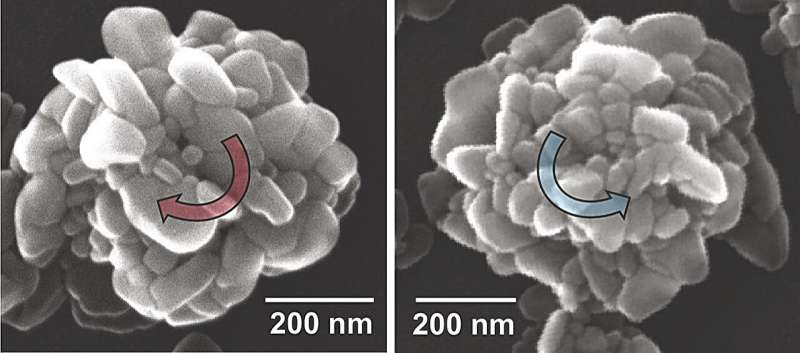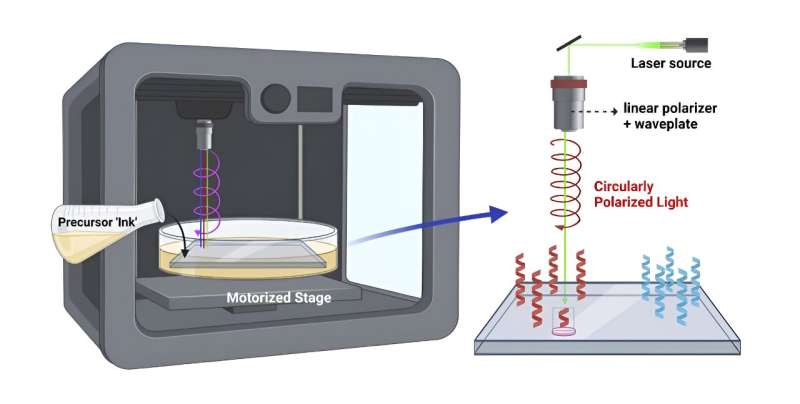
A new fabrication process for helical metal nanoparticles provides a simpler, cheaper way to rapidly produce a material essential for biomedical and optical devices, according to a study by University of Michigan researchers.
“One of our motivators is to drastically simplify manufacturing of complex materials that represent bottlenecks in many current technologies,” said Nicholas Kotov, the Irving Langmuir Distinguished University Professor of Chemical Sciences and Engineering at U-M and co-corresponding author of the study, published in Proceedings of the National Academy of Sciences.
Chiral surfaces—meaning the surface lacks mirror symmetry (e.g., a left and right hand)—that have the ability to bend light at the nanoscale are in high demand. The new study demonstrates a way to make them by 3D-printing “forests” of nanoscale helices. Aligning the helices’ axes with a light beam creates strong optical rotation, enabling chirality to be harnessed in health and information technologies, for which chirality is common.
Chiral surfaces from plasmonic metals are even more desirable because they can produce a large family of very sensitive biodetectors. For example, they can detect specific biomolecules—produced by dangerous drug-resistant bacteria, mutated proteins or DNA—which can aid the development of targeted therapeutics. These materials also offer potential to advance information technologies, creating larger data storage capacities and faster processing speeds by harnessing the interaction of light with electronic systems (i.e., fiber optic cables).
Although these special 3D-structured surfaces from stand-up helices are much needed, the traditional methods to make them are complex, expensive and create a lot of waste.

Most commonly these materials are made using highly specialized hardware—such as two-photon 3D lithography or ion/electron-beam-induced deposition—only available in a few high-end facilities. Although accurate, these methods involve time-consuming, multi-step processing at low pressure or high temperature conditions.
3D printing has been suggested as an alternative, but existing 3D printing technologies do not allow nanoscale resolution. As a solution, the U-M research team developed a method that uses helical light beams to produce nanoscale helices with specific handedness and pitch.
“Centimeter-scale chiral plasmonic surfaces can be produced within minutes using inexpensive medium-power lasers. It was amazing to see how fast these helical forests grow,” said Kotov.
The 3D printing of helical structures by helical light is based on the light-to-matter chirality transfer discovered at U-M about 10 years ago.
Single-step, mask-free, direct-write printing from aqueous solutions of silver salt provides an alternative to nanolithography while advancing 3D additive manufacturing. The processing simplicity, high polarization rotation and fine spatial resolution of light-driven printing of helices from metal will greatly accelerate the preparation of complex nanoscale architecture for the next generation of optical chips.
More information:
Ji-Young Kim et al, Direct-write 3D printing of plasmonic nanohelicoids by circularly polarized light, Proceedings of the National Academy of Sciences (2024). DOI: 10.1073/pnas.2312082121
Provided by
University of Michigan College of Engineering

READ MORE
Researchers investigate three star-forming regions, identify hundreds young stellar objects
A color-composite image of the IRAS 05168+3634 star-forming region, combining data of WISE 12 µm [...]
Five Things We Learned from Victor Glover
NASA astronaut and Pilot Victor Glover launched from the International Space Station on the agency’s [...]
Scientists thread rows of metal atoms into nanofiber bundles
(a) 3D TMC crystalline structure consisting of TMC nanofibers surrounded by single-atom rows of an [...]
What is Causing Iran’s Spike in MS Cases?
Edel Rodriguez Multiple sclerosis has skyrocketed in Tehran, increasing almost sevenfold between 1989 and 2005. [...]
Explaining Diameter Measurements Used in Wire, Nail, and Bullet Sizes
The size of a bullet is measured in calibers. Cliff Volpe/Getty Images Deciphering the specifics [...]
Applying semiconductor manufacturing principles to optoelectronic devices
This graphic shows how the Lewis acid treatment, p-type doping, and tin chloride concentrations and [...]
Exploring 7 of Earth’s Great Mountain Ranges
Ray Atkeson/Encyclopædia Britannica, Inc. Like hiking? Then come and explore the plants and animals of [...]
Using Zinc to Detect Breast Cancer Early
The way cancer cells process zinc might help scientists identify a new biomarker. Callista Images/cultura/Corbis [...]